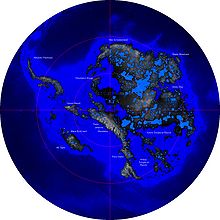The Prehistory of Antarctica PortalIn general... The geology of Antarctica covers the geological development of the continent through the Archean, Proterozoic and Phanerozoic eons. The geological study of Antarctica has been greatly hindered by the fact that nearly all of the continent is continuously covered with a thick layer of ice. However, techniques such as remote sensing have begun to reveal the structures beneath the ice. Geologically, West Antarctica closely resembles the Andes of South America.[page needed] The Antarctic Peninsula was formed by uplift and metamorphism of sea-bed sediments during the late Paleozoic and the early Mesozoic eras. This sediment uplift was accompanied by igneous intrusions and volcanism. The most common rocks in West Antarctica are andesite and rhyolite volcanics formed during the Jurassic Period. There is also evidence of volcanic activity, even after the ice sheet had formed, in Marie Byrd Land and Alexander Island. The only anomalous area of West Antarctica is the Ellsworth Mountains region, where the stratigraphy is more similar to the eastern part of the continent. (Full article...) Selected article on prehistoric Antarctica
The Temnospondyli are a diverse order of small to giant tetrapods—often considered primitive amphibians—that flourished worldwide during the Carboniferous, Permian, and Triassic periods. A few species continued into the Cretaceous. Fossils have been found on every continent. During about 210 million years of evolutionary history, they adapted to a wide range of habitats, including fresh water, terrestrial, and even coastal marine environments. Their life history is well understood, with fossils known from the larval stage, metamorphosis, and maturity. Most temnospondyls were semiaquatic, although some were almost fully terrestrial, returning to the water only to breed. These temnospondyls were some of the first vertebrates fully adapted to life on land. Although temnospondyls are considered amphibians, many had characteristics, such as scales, claws, and armor-like bony plates, that distinguish them from modern amphibians.
Authorities disagree over whether temnospondyls were ancestral to modern amphibians (frogs, salamanders, and caecilians), or whether the whole group died out without leaving any descendants. Different hypotheses have placed modern amphibians as the descendants of temnospondyls, another group of early tetrapods called lepospondyls, or even as descendants of both groups (with caecilians evolving from lepospondyls and frogs and salamanders evolving from temnospondyls). Recent studies place a family of temnosondyls called the amphibamids as the closest relatives of modern amphibians. Similarities in teeth, skulls, and hearing structures link the two groups. (see more...) Selected article on the prehistory of Antarctica in human science, culture and economics
The history of paleontology traces the history of the effort to study the fossil record left behind by ancient life forms. Although fossils had been studied by scholars since ancient times, the nature of fossils and their relationship to life in the past became better understood during the 17th and 18th centuries. At the end of the 18th century the work of Georges Cuvier ended a long running debate about the reality of extinction and led to the emergence of paleontology as a scientific discipline.
The first half of the 19th century saw paleontological activity become increasingly well organized. This contributed to a rapid increase in knowledge about the history of life on Earth, and progress towards definition of the geologic time scale. As knowledge of life's history continued to improve, it became increasingly obvious that there had been some kind of successive order to the development of life. After Charles Darwin published Origin of Species in 1859, much of the focus of paleontology shifted to understanding evolutionary paths. The last half of the 19th century saw a tremendous expansion in paleontological activity, especially in North America. The trend continued in the 20th century with additional regions of the Earth being opened to systematic fossil collection, as demonstrated by a series of important discoveries in China near the end of the 20th century. There was also a renewed interest in the Cambrian explosion that saw the development of the body plans of most animal phyla. (see more...) Need help?Do you have a question about Abyssal/Prehistory of Antarctica that you can't find the answer to? Consider asking it at the Wikipedia reference desk. Did you know?
SubcategoriesThings you can do
Related contentAssociated WikimediaThe following Wikimedia Foundation sister projects provide more on this subject:
Category:Portals with titles not starting with a proper noun |
























